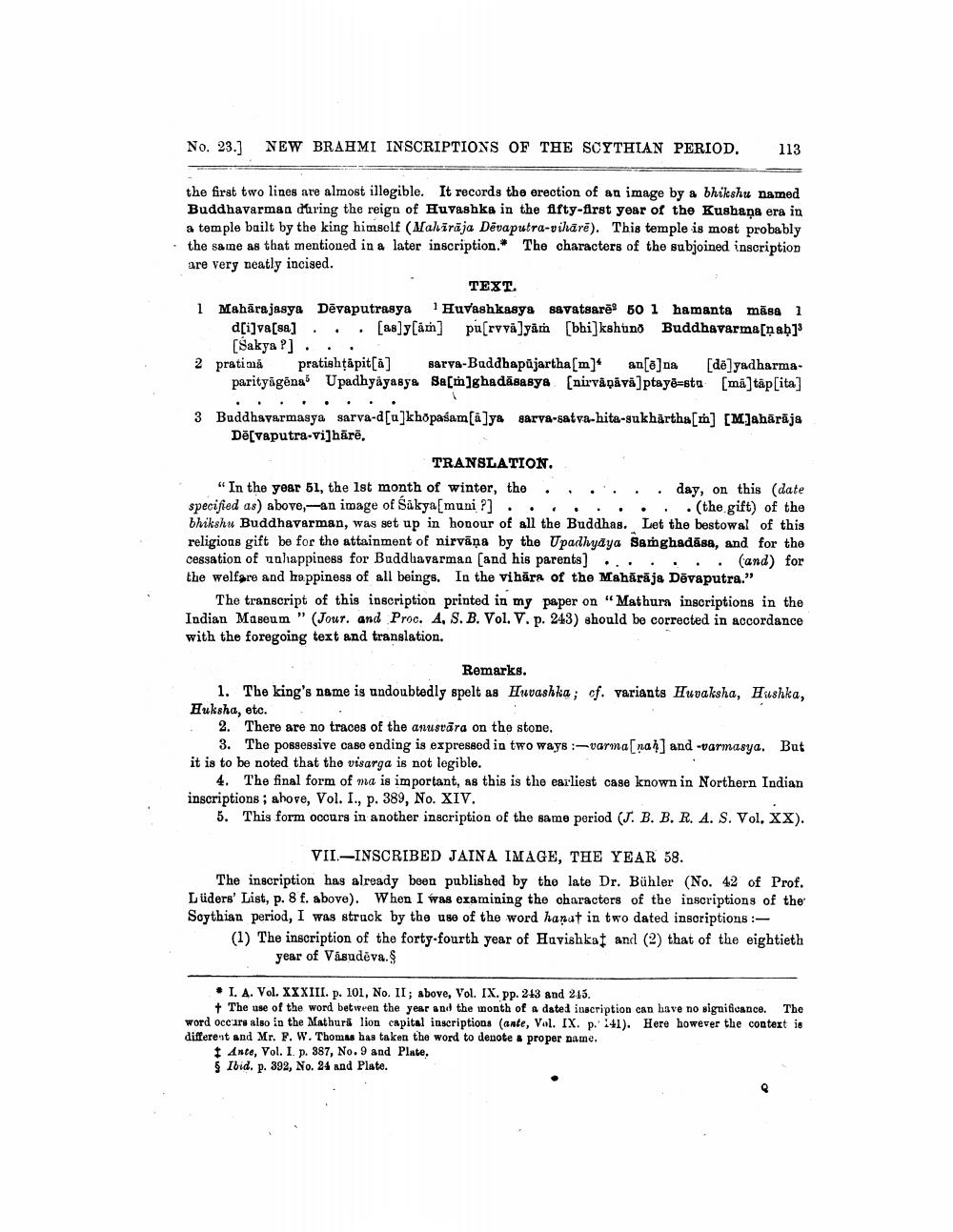________________
No. 23.]
the first two lines are almost illegible. It records the erection of an image by a bhikshu named Buddhavarman during the reign of Huvashka in the fifty-first year of the Kushana era in a temple built by the king himself (Mahārāja Dēvaputra-vihare). This temple is most probably the same as that mentioned in a later inscription. The characters of the subjoined inscription are very neatly incised.
NEW BRAHMI INSCRIPTIONS OF THE SCYTHIAN PERIOD. 113
TEXT.
1 Huvashkasya savatsare 50 1 hamanta masa 1 [][] purva]yah [bh]kshan Buddhavarma[ab]'
1 Maharajasya Devaputrasya d[i]va[sa] [Sakya?]
2 pratimă pratishṭāpit[a] sarva-Buddhapujartha [m]* an[8]an [de]yndharmaparityagēna Upadhyayasya Sa[m]ghadasasya [nirväpävä]ptaye-stu [ma]täp[ita]
3 Buddhavarmasya sarva-d[u]khopaśam[a]ya sarva-satva-hita-sukhartha[m] [M]ahārāja De[vaputra-vi]hārē,
TRANSLATION.
"In the year 51, the 1st month of winter, the
day, on this (date
•
specified as) above,-an image of Sakya[muni ?]. (the gift) of the bhikshu Buddhavarman, was set up in honour of all the Buddhas. Let the bestowal of this religions gift be for the attainment of nirvana by the Upadhyaya Samghadass, and for the cessation of unhappiness for Buddhavarman [and his parents] .... .. (and) for the welfare and happiness of all beings. In the vihara of the Mahārāja Dēvaputra."
The transcript of this inscription printed in my paper on "Mathura inscriptions in the Indian Maseum" (Jour. and Proc. A, S. B. Vol. V. p. 243) should be corrected in accordance with the foregoing text and translation.
Remarks.
1. The king's name is undoubtedly spelt as Huvashka; cf. variants Huvaksha, Hushka, Huksha, etc.
2. There are no traces of the anusvara on the stone.
3. The possessive case ending is expressed in two ways:-varma [nah] and -varmasya. But it is to be noted that the visarga is not legible.
4. The final form of ma is important, as this is the earliest case known in Northern Indian inscriptions; above, Vol. I., p. 389, No. XIV.
5. This form occurs in another inscription of the same period (J. B. B. R. A. S. Vol. XX).
VII-INSCRIBED JAINA IMAGE, THE YEAR 58.
The inscription has already been published by the late Dr. Bühler (No. 42 of Prof. Lüders' List, p. 8 f. above). When I was examining the characters of the inscriptions of the Scythian period, I was struck by the use of the word hapat in two dated inscriptions:
(1) The inscription of the forty-fourth year of Huvishkat and (2) that of the eightieth year of Vasudeva.§
I. A. Vol. XXXIII. p. 101, No. II; above, Vol. IX. pp. 243 and 245.
The
The use of the word between the year and the month of a dated inscription can have no significance. word occurs also in the Mathura lion capital inscriptions (ante, Vol. IX. p. 141). Here however the context is different and Mr. F. W. Thomas has taken the word to denote a proper name.
Ante, Vol. I. p. 387, No. 9 and Plate,
§ Ibid. p. 392, No. 24 and Plate.




